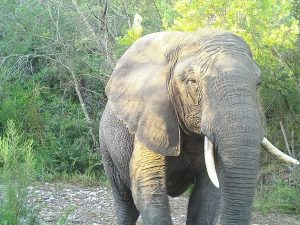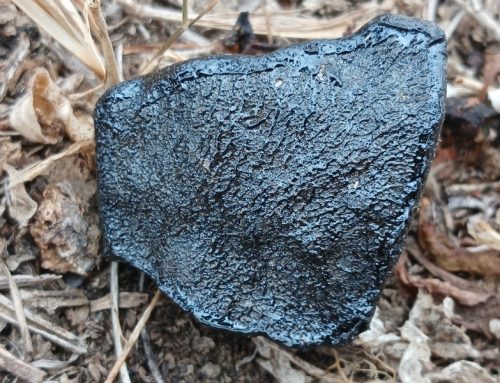 Only one elephant remains in the Knysna forest and surrounding fynbos: a mature female. There is enormous pathos and tragedy in this finding as she is the last truly wild, free roaming elephant in South Africa and the southernmost in the world.
Only one elephant remains in the Knysna forest and surrounding fynbos: a mature female. There is enormous pathos and tragedy in this finding as she is the last truly wild, free roaming elephant in South Africa and the southernmost in the world.
The finding was recently published in a scientific article titled And Then There Was One by leading mammal scientists, following a rigorous camera trap survey, using 72 passive infrared-triggered cameras, 24/7 from July 2016 to October 2017 in the Knysna elephant range that spans 185 km².
This range includes the Garden Route National Park, privately-owned commercial timber plantations and privately-owned forested land. The Knysna elephants have always moved directionally and seasonally along clearly-defined elephant pathways between feeding patches and water in the area.
“There has been a debate for years now about how many Knysna elephants there are, as they are difficult to see or locate,” says Professor Graham Kerley from the Centre for African Conservation Ecology at Nelson Mandela University, one of six renowned mammal researchers who participated in the research and co-authored the article. The others are Lizette Moolman, Melanie de Morney and Dr Sam Ferreira from the South African National Parks Scientific Services; Prof André Ganswindt from the Mammal Research Institute at the University of Pretoria, and Dr Joyce H. Poole from ElephantVoices, Norway.
“To have it confirmed that there is only one Knysna elephant left is a shock to many as there is a deep aura of mystique and mythology around them, fueled by their elusiveness, and by stories like Dalene Matthee’s Circles in a Forest.” It talks about the destruction of the great indigenous Outeniqua forests and the hunting and persecution of elephants over the centuries.
To conduct the survey, the 72 cameras were deployed at 38 locations within the elephant range and set to take high-quality images with a 1-second interval between sequential photographs, and a 2-second delay between video clips. They were fastened to trees within 1 m of elephant-used roads and paths, at a height of 1–1.5 m. Recent technological improvements in camera trap technology makes it a widely used, reliable application in ecological studies.
“The cameras were all active for 15 months, and covered the range evenly during this time, ensuring there were no gap areas where elephants might reside undetected,” explains SANPark scientist Moolman.
Over a period of 17 306 active camera trapping days, a total of 5195 elephant photographs or video clips (15–30 seconds each) were captured, in 144 capture events. All of these solely identified one heavy, round-bodied adult female with a highly wrinkled forehead that forms a unique, easily identified pattern. “She is about 45 years old and moves in the indigenous forest and fynbos areas on SANParks and neighbouring private land,” says Moolman.
Elephants have unique individual physical features such as ear notch patterns and tusk shape and size, makes them individually identifiable. In addition to this female’s shape and forehead, she has‘unique ‘serrated’ ear notch patterns on both her left and right ears and relatively wide-spaced asymmetrical unbroken tusks, the left tusk higher than the right tusk.
“The brutal reality is there is no longer a population of Knysna elephants. All the mystique of the Knysna elephant is reduced to a single elephant left in rather tragic circumstances,” says Kerley. Female elephants are not meant to be alone – they spend their lives in family units of related adult females with their calves.
The images reveal that although she is a fully mature adult female, she lacks developed breasts, because she is neither pregnant nor lactating. Her shrivelled mammary glands suggest that she has not had a calf in a long time, if ever.
Kerley adds that she appears to be in reasonably good condition with the exception of her swollen temporal glands with excessive temporal streaming, suggests that she is experiencing stress, very possibly as a result of being alone.
“Considering all these factors, the debate about how we have allowed this population to go functionally extinct and how to manage the last elephant is very emotional and very serious as she is a symbol of how we are treating biodiversity as a whole,” he explains.
“It is a societal responsibility as we have forced these elephants, which are savanna elephants, into inhospitable forest habitats as a result of hundreds of years of hunting them and chasing them out of their natural habitat.”
We call them the Knysna forest elephants but the forest is not their typical habitat.
Moolman explains: “The Knysna elephant is of the same subspecies as all the other savanna elephant populations in South Africa, namely Loxodonta africana. The elephants that roam in Central African rainforests are of a different subspecies namely Loxodonta cyclotis.”
The leaves of the Knysna forest trees are low in protein and high in fibre – a poor quality food. Most of the forest canopy is also 30 -40 m high, and out of browsing reach. By deduction the Knysna elephants supplement their diet on the forest edge and in the fynbos.
Historically the Knysna elephants roamed in their thousands as a continuous population for hundreds of kilometres along the southern Cape coast. They had access to thickets, fynbos and Karoo habitat. Over the past 300 odd years they were forced, as a result of persecution and human encroachment, to retreat into the forest as a refugee population.
By 1876 as a result of hunting and persecution, the thousands of southern Cape and Knysna elephants were down to 400 to 500 animals (according to the Conservators of Forests’ official reports). In 1920 a Major P J Pretorius conducted the last known legal hunt of Knysna elephants – he had a permit to kill one elephant, but five died in the process reducing the elephants to approximately 13 animals. By 1970 they were down to 11 (Wildlife Society Survey); by 1981 down to 3 (Forestry Department records).
In 2007 a faecal DNA genotyping survey (Eggert, Patterson & Maldonado) suggested an increase to 5 female elephants, a calf and a breeding male, but this kind of survey only provides statistical estimates of population size, not an actual count, which the camera survey does.
An added limitation to faecal DNA surveys is that dung freshness affects the reliability of the DNA genotyping results. Kerley says the dung should not be older than 12 hours when tested, and preferably much fresher, ideally “still steaming”.
Of the 18 genotyped dung samples for the Knysna elephant DNA 2007 survey, five were older than five days and the rest were reported to be between one and four days old. It is likely that this may have led to unreliable results and an overestimate of numbers.
Rigorous follow-up counts have been neglected, and we are now down to one. She could live to 65 years, as elephants do, and she could be in the forest for another 20 years, or not, we just don’t know.
“Managing her is a huge challenge because she is very shy and avoids humans,” Kerley explains. “It is not viable to introduce savanna elephants from other populations – from Addo or Kruger – to the forest. This was tried with three young Kruger elephants in September 1994 and it failed. In less than a month one died of stress-related pneumonia The other two left the forest causing human-elephant conflict and they ultimately had to be moved to Shamwari Game Reserve.
The last Knysna elephant has the same genetics as the Addo and Kruger populations and so the question has been raised, whether she should be translocated out of the forest to a herd.
“The option of capturing her and moving her somewhere else would be dangerous for her and we don’t know if it would even be of any value to her as she only knows the forest and she might not be able to settle into another area with other elephants,” says Kerley. The same goes for any attempts at artificial insemination, it’s too risky and if it was decided to attempt the ‘impregnation’ route, it would be better to move her to another elephant population, which, as Kerley said, could be too traumatic for her.
He says a major voice that needs to be considered in the decision about her management, is the people of Knysna – who, in all probability, would not want to see her go. “It comes down to a societal decision as it is no longer a population decision, it is about the last Knysna elephant’s well-being. My personal opinion is that we should leave her be.
“Hopefully as humans, we have learnt a nasty lesson because it is ultimately our fault that we are down to the last elephant here. She is the metaphor for our treatment of all species that live on this planet with us. The saying ‘the elephant in the room’ could not be more apt; she is telling us we are making some big mistakes and we are going to lose a lot more than her if we don’t substantially change how we treat and value biodiversity.”




